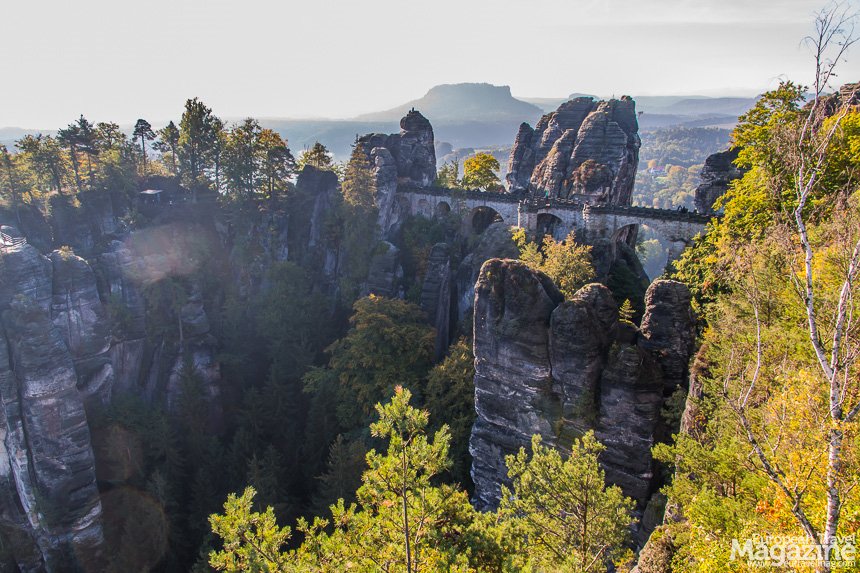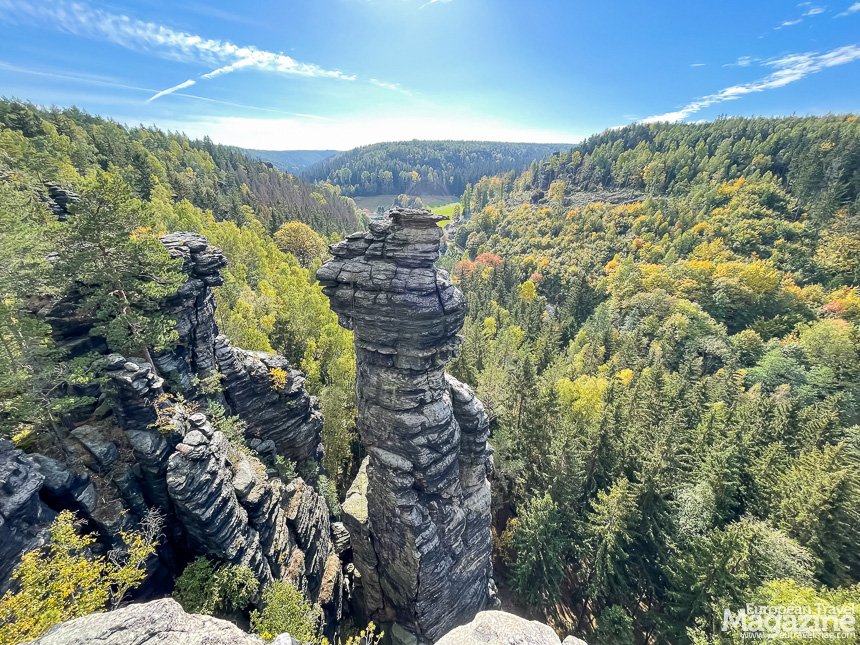Seldom have we stayed in a more enchanting realm. Saxon Switzerland impresses with imposing table mountains and bizarre rock formations. It ignites your imagination with its gnarled forest paths, moss-clad boulders and narrow ravines from where a light mist emanates, like if this ancient earth quietly exhaled. It’s easy to believe in gnomes and elves in this fairytale landscape.
Saxon Switzerland is a National Park in the east of Germany, in the region of Saxony, close to the Czech border. On the Czech side they, on the other hand, have their Bohemian Switzerland National Park. The two parks share the same natural wonder: the Elbe Sandstone Mountains. This is one of the most peculiar landscapes of Europe: The mountains are flat on top, the rocks have bizarre forms and the climate is upside-down.
Geological wonder

The sand sticking to your hiking boot, when you’re out exploring the area, is with compliments from prehistoric times, 140 million years ago, when the area was covered by ocean.
Over millions of years, layers of sand and other minerals were deposited here, reaching a thickness of 600 metres. Slowly, these layers compressed and solidified into sandstone. Around 100 million years ago, the sandstone plate lifted and broke into pieces. The Cretaceous seas retracted, and frost, wind and water began their slow and patient remoulding of the sandstone. Volcanos erupted here and there, giving birth to the conic hills of today, such as Raumberg, Grosser and Kleiner Winterberg (any name ending with -berg, tells a tale of a volcanic origin).
Over the course of millions of years, the Elbe river cuts even deeper into the sandstone, and it eroded into gorges and valleys, peculiar geoforms and the table mountains that tower majestically above the Elbe river today. Lilienstein, Königstein and all other -stein are all born out of the sandstone and thus share that family name.
The rocks you encounter along the way will tell you their own tale of this long history. Eventually, in thousands of years, they too will end up as sand below our feet. Better go out and enjoy them while we can.
Hiker’s paradise

Hiking is first and foremost the most intensive way to experience the diversity of the landscape of the Elbe Sandstone Mountains. There are more than 1.000 kilometres of hiking trails in Saxon Switzerland alone. And only rarely does it just go straight. Bridges lead over gorges and fissures, trails lead to panoramic views or follows a clear stream in the forest valley. And on the rims of the table mountains, stairs and iron ladders await the adventurous hiker.
The rocks come within reach. You can read the million-year-old history on their surface and try to grasp the geologic development of the area. Our favourite hikes were those of Bastei, Bielatal, Pfaffenstein and Affensteine.
Romantic painters – and a trail to discover them

We have climbed the trail for what seems like an eternity. Then, arrived at the proper height, the Elbe river flows graciously under us, still fighting the morning fog that clings to its waters. It’s a fairytale view from the Schrammsteine – no wonder that it inspired many Romantic painters and writers 200 years ago, eventually turning the Saxon Switzerland to an early tourist destination in Germany.
“Der Wanderer über dem Nebelmeer” is a famous painting from 1818 by Caspar David Friedrich and exemplifies the Romantic movement and advertises the view in brushstrokes. And every view from the Carolafelsen could easily double as the famous background of the painting. But then again; so could countless others on the so-called Malerweg, the Painter’s Trail.
This 116 kilometre hiking route will take you past some of the most picturesque landscapes of the Elbe Sandstone Mountains. And though you may not have brought your brush and easel, like the painters of the Romantic movement did 200 years ago, you can capture these immortal views on camera.
Top 5 Saxon Switzerland
Saxon Switzerland is a perfect destination for a one-week getaway! Combining trips to the natural attractions in the national park with visits to Dresden with its refine baroque architecture and exquisite art museums, makes a perfect combo for practically everyone!
With so much to see and so little time, we’ve boiled down the highlights to our personal Top5 of the things you definitely shouldn’t miss and which would give you an overall sense of the grandeur of Saxon Switzerland!
Bastei: Iconic natural attraction

These jagged rock formations are one of the most iconic, natural attractions of the Saxon Switzerland. They rise 194 metres above the Elbe River and were formed by water erosion million years ago.
Because of its popularity we chose (wisely, in hindsight) to arrive early as to catch the morning fog before it lifted, as well as catching a free parking space before they were lacking.
Both the hike on the Bastei, looking down at the rock formations, and the subsequent stroll through the so-called Schwedenlöcher, looking up at the towering boulders, was deservedly one of the best in Saxon Switzerland!
Bielatal: Gigantic Geoformations

As we climb yet another steep rock, we are suddenly there: at the Herkulessäulen. These slender rock pillars rise 35 meters from the forest floor and even though they look awfully fragile, they are robust enough to accommodate climbers. A climber rappels down the seemingly insurmountable rock face. Just to prove our point.
The Hercules pillars are but a few of the many bizarre rock formations throughout the entire Biela valley. With 239 peaks it’s also the largest climbing area in Saxon Switzerland. And even if you’re not a climber, this is a great place to get close and personal with these wonders of nature.
Schrammsteine & Affensteine: Dramatic views and daring trails

Ding! “Welcome to Czech Republic” our phones proclaim. Ding! “Welcome to Germany” an SMS 2 minutes later greets us.
We have begun our hike to the so-called Affensteine (Monkey stones) and Carolafelsen (Carola Rock) from the charming village of Schmilka, just 400 metres from the Germany-Czech border. And although the trail doesn’t cross any border, our phones trumpet their imagined international travels.
This area is the southernmost of the national park Saxon Switzerland and awards you with amazing views. But not until you’ve earned them by schlepping yourself 250 vertical metres up the trail.
At every turn there is a new perspective. Across treacherous roots, under giant boulders and along steep cliffs, the trail meanders through the jagged mountains. Carolafelsen offers both awe-inspiring views as well as a sun-kissed spot to enjoy the lunch, before we head back on the trail. The upper Affensteine trail will take you through this amazing area, that offers probably the most challenging hikes in Saxon Switzerland. Stay tuned for another article about the best hiking routes in Saxon Switzerland, where we’ll describe the best trail to discover Schrammsteine, Affensteine and Carolafelsen.
Kirnitzschklamm: Boat On The Border
 The small river of Kirnitzsch is a minuscule version of that prehistoric body of water that carved out the valley of Kirnitzschtal and made it one of the most popular entryway into the heart of Saxon Switzerland.
The small river of Kirnitzsch is a minuscule version of that prehistoric body of water that carved out the valley of Kirnitzschtal and made it one of the most popular entryway into the heart of Saxon Switzerland.
After having followed the winding road through the pretty valley and left the tourist masses behind us, we park the car and hike down towards the river. We are going on a boat ride.
The Kirnitzsch river follows the border between Germany and Czech Republic at this point, and is dammed for about 700 metres. On this dam, small boats have paddled tourists through the enchanting canyon since 1879. The barred river is no more than 8°C and a light mist emanates from its dark surface as the boatman ferries us along through the narrow gorge. On both sides of the river, border plates tell their story of a time when the country to the right was named DDR and the country to the left was Czechoslovakia.
The boat ride only takes 30 minutes and we could easily have saved the 8€ per person by hiking along the river. BUT then we wouldn’t have heard all those fun tales of the ferryman, or seen the steep cliffs reflect in the murky water the same way.. A (boat)trip worth taking – especially with children.
Pfaffenstein & Barbarine: Close contact with the Elbe Sandstone Mountains

If you want to get intimate with one of the iconic table mountains of Saxon Switzerland, we suggest a visit to Pfaffenstein. It’s not a far walk from the car park, it’s not a strenuous climb and yet you’re awarded with towering cliffs, narrow gorges and perfect views to the rest of this amazing National Park.
We recommend to take the “Klammweg” up; the road left of the imposing Jäckelfels. Here, stairs will take you intimately close to the mountain until you reach a plateau where there’s a small inn. You can replenish here in the summer months, before exploring the ruins and venture through the narrow “Hohle Gasse“, probably regretting if you had too much to eat in the inn. Reaching another plateau, you are awarded with impressive views to the south. Remember to go into that little crevasse to the left where you get up close and personal with the geoformation “Barbarine” that stands like a tall phallic symbol pointing to the east.
If you’re sure-footed and have brought a headlamp, I suggest coming here for the sunrise, as you’re granted magical views of the sun rising over Saxon Switzerland.
Learn more
-
- Saxon Switzerland official website
- Saxon Switzerland on Saxony Tourism official website
- Saxon Switzerland National Park website
- Saxon Switzerland on Wikipedia
Discover more



